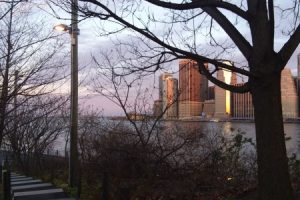
The coronavirus crisis, for the lucky among us, reintroduces the public park as a place of restoration, peace and pleasure.
In fact, parks and open space confer crucial health benefits on everyone. Those who need those benefits most often lack access to parks. That comprises a public health crisis of its own.
In this op-ed, two leaders of of the Conservation Finance Network lay out models for investing in open space for everyone and make the case for adapting these models widely and deeply to work our way out of the current crisis.
In the nation’s Covid epicenter, a well-funded park stokes wellness.
New York City’s Brooklyn Bridge Park, here on a morning during the Covid shutdown, blends public and private capital to broaden open space access. More neighborhoods need parks like thi
America has a long tradition of creating public parks and open space, from the rugged wilds of our National Parks and National Forests to the pocket park down the road from our homes. Today, in the midst of Covid-19 social distancing, those of us who are fortunate to have access to nearby open spaces are relying on them more than ever for our mental and physical health. This is thanks to the work of hundreds of local land trusts, conservation commissions, NGOs, and volunteer organizations that save these lands for our enjoyment.
In communities across the United States, it seems the wildlands and woodlands are more popular than ever. Trails and parks offer us peace, recreation, and rejuvenation. Whether you seek the song of a bird, the peep of a peeper, or the inner quiet of your thoughts, nature offers both respite from the anxiety of pandemic life and a place to stretch with family.
At least for the fortunate ones. According to the Trust for Public Land, over 100 million city-dwelling Americans have no park or open space within a 10-minute walk from their homes. And many don’t even have easy access with a short drive from their homes. This is an important public health and equity problem because research shows that access to parks has substantial health benefits.
According to the Centers for Disease Control and Prevention, proximity to parks and green space has been associated with reductions in self-reported stress and depressive symptoms, and with improved attention, self-discipline, social ties, and quality of life. An analysis by the Yale School of Public Health and the Yale School of Forestry and Environmental Studies estimated that the reduced rates of chronic heart-related conditions due to access to green space saves the healthcare system $37 million per year in the greater New Haven, CT region alone. Additionally, green infrastructure in urban areas, such as street trees and streams, manages stormwater and mitigates asthma-causing air pollution.
Emerging analysis of the Covid-19 pandemic in the United States shows that communities with higher levels of air pollution caused by a history of environmental injustices may be particularly susceptible to the new disease. These communities are less likely to have access to parks and well-mainted green spaces and their associated health benefits. Left unaddressed, this will continue to exacerbate the health risks to these communities long after the current crisis fades.
Conservation contributes in so many environmental and economic ways to our communities, yet public investments in preserving open space are wholly insufficient. In response, we see innovation and action from public, private, and nonprofit groups working to increase the financial resources available for public open space creation and management. This is a testament to the ability of the conservation community to think creatively and engage new stakeholders to fund their work. At the Conservation Finance Network, we are privileged to feature these organizations in our trainings and resources as they address the intertwined issues of community health, equity, and access to open space in holistic and durable ways.
For example, the Willamette Partnership in Portland, OR, developed a guide for land trusts and conservation groups to make the case for the public health benefits of their work to audiences interested in developing and funding health initiatives. The Freshwater Land Trust in Birmingham, AL, received funding from the Centers for Disease Control to develop a master plan for greenways that has protected regional waterways while providing bicycle and pedestrian infrastructures that promote active and healthy living.
Through the Parks with Purpose program, The Conservation Fund acquires land on behalf of cities to establish parks in urban areas. The Conservation Fund then works with the communities not only to restore the land, but also to implement benefits such as green infrastructure for flood management and the remediation of air and water pollution.
Carbon markets also have promise for putting money on the ground for community conservation work. California awarded Fresno $66 million in proceeds through its carbon cap-and-trade program to cut emissions in the city’s disadvantaged communities. It will build walking trails and bike paths. Austin and Washington’s King County are testing carbon credits for planting and protecting urban trees by working with the NGO City Forest Credits.
Our parks, natural areas, and open spaces help make up the fabric of our communities. Yet we often do not notice them until we need them most. While medical professionals bravely respond to the pandemic, our local conservationists remain busy tending to one of our best preventative medicines: our shared opportunity to enjoy nature. Let us remember how much we rely on our open spaces and parks in this time of need, now and long after this crisis ends. When we take care of the land, it takes care of us.
This op-ed was originally published on Conservation Finance Network.org Allegra Wrocklage is Program Manager at the Conservation Finance Network. Spencer Meyer is Senior Conservationist at the Highstead Foundation.